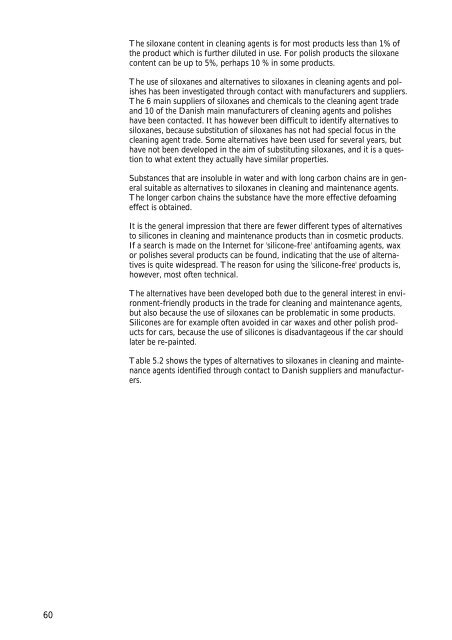No. 1031 - Miljøstyrelsen
No. 1031 - Miljøstyrelsen
No. 1031 - Miljøstyrelsen
You also want an ePaper? Increase the reach of your titles
YUMPU automatically turns print PDFs into web optimized ePapers that Google loves.
60<br />
The siloxane content in cleaning agents is for most products less than 1% of<br />
the product which is further diluted in use. For polish products the siloxane<br />
content can be up to 5%, perhaps 10 % in some products.<br />
The use of siloxanes and alternatives to siloxanes in cleaning agents and polishes<br />
has been investigated through contact with manufacturers and suppliers.<br />
The 6 main suppliers of siloxanes and chemicals to the cleaning agent trade<br />
and 10 of the Danish main manufacturers of cleaning agents and polishes<br />
have been contacted. It has however been difficult to identify alternatives to<br />
siloxanes, because substitution of siloxanes has not had special focus in the<br />
cleaning agent trade. Some alternatives have been used for several years, but<br />
have not been developed in the aim of substituting siloxanes, and it is a question<br />
to what extent they actually have similar properties.<br />
Substances that are insoluble in water and with long carbon chains are in general<br />
suitable as alternatives to siloxanes in cleaning and maintenance agents.<br />
The longer carbon chains the substance have the more effective defoaming<br />
effect is obtained.<br />
It is the general impression that there are fewer different types of alternatives<br />
to silicones in cleaning and maintenance products than in cosmetic products.<br />
If a search is made on the Internet for 'silicone-free' antifoaming agents, wax<br />
or polishes several products can be found, indicating that the use of alternatives<br />
is quite widespread. The reason for using the 'silicone-free' products is,<br />
however, most often technical.<br />
The alternatives have been developed both due to the general interest in environment-friendly<br />
products in the trade for cleaning and maintenance agents,<br />
but also because the use of siloxanes can be problematic in some products.<br />
Silicones are for example often avoided in car waxes and other polish products<br />
for cars, because the use of silicones is disadvantageous if the car should<br />
later be re-painted.<br />
Table 5.2 shows the types of alternatives to siloxanes in cleaning and maintenance<br />
agents identified through contact to Danish suppliers and manufacturers.

















